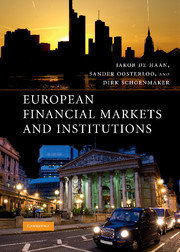Book contents
- Frontmatter
- Contents
- List of Boxes
- List of Figures
- List of Tables
- List of Countries
- List of Abbreviations
- Preface
- Part I Setting the Stage
- 1 Functions of the Financial System
- 2 European Financial Integration: Origins and History
- Part II Financial Markets
- Part III Financial Institutions
- Part IV Policies for the Financial Sector
- Index
- References
1 - Functions of the Financial System
from Part I - Setting the Stage
- Frontmatter
- Contents
- List of Boxes
- List of Figures
- List of Tables
- List of Countries
- List of Abbreviations
- Preface
- Part I Setting the Stage
- 1 Functions of the Financial System
- 2 European Financial Integration: Origins and History
- Part II Financial Markets
- Part III Financial Institutions
- Part IV Policies for the Financial Sector
- Index
- References
Summary
OVERVIEW
Having a well-functioning financial system in place that directs funds to their most productive uses is a crucial prerequisite for economic development. The financial system consists of all financial intermediaries and financial markets and their relations with respect to the flow of funds to and from households, governments, business firms, and foreigners, as well as the financial infrastructure.
The main task of the financial system is to channel funds from sectors that have a surplus to sectors that have a shortage of funds. In doing so, the financial sector performs two main functions: (1) reducing information and transaction costs, and (2) facilitating the trading, diversification, and management of risk. These functions are discussed at length in this chapter.
The importance of financial markets and financial intermediaries differs across Member States of the European Union (EU). An important question is how differences in financial systems affect macroeconomic outcomes. Atomistic markets face a free-rider problem: when an investor acquires information about an investment project and behaves accordingly, he reveals this information to all investors, thereby dissuading other investors from devoting resources towards acquiring information. Financial intermediaries may be better able to deal with this problem than financial markets.
This chapter discusses these and other pros and cons of bank-based and market-based systems. A specific element in this debate is the role of corporate governance, i.e. the set of mechanisms arranging the relationship between stakeholders of a firm, notably holders of equity, and the management of the firm.
- Type
- Chapter
- Information
- European Financial Markets and Institutions , pp. 3 - 32Publisher: Cambridge University PressPrint publication year: 2009



